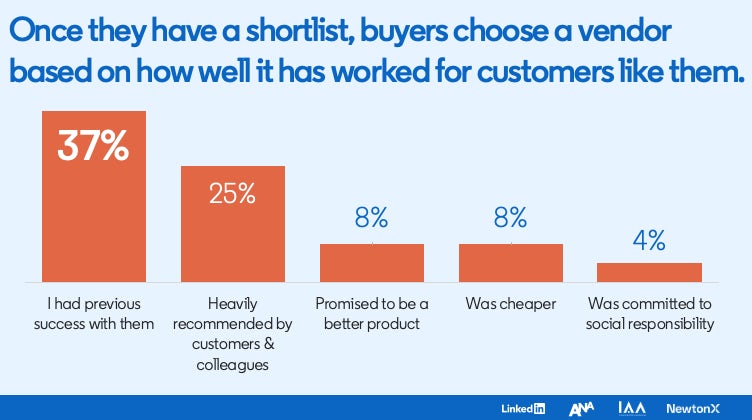B2B marketers need to show how their runs are scored
The ‘buyability’ model unifies brand and demand, and helps attribute revenue, with a strategy built around B2B buyers’ needs and how they make decisions.

In the baseball movie Moneyball, Brad Pitt plays Billy Beane, manager of the Oakland Athletics, a losing team whose players are being sold off for parts. With little money and a lot to prove, he enlists help from baseball analyst Peter Brand (played by Jonah Hill) and bets on a new strategy to get ahead.
In a pivotal scene, Brand explains that Beane does not need to sign big-name players to win games. What he needs is a clearer picture of what drives results.
“You’re trying to replace Johnny Damon. When the Boston Red Sox see Johnny Damon, they see a star who’s worth $7.5m a year. When I see Johnny Damon, what I see is an imperfect understanding of where runs come from.”
Together, they rewrite the rules of player selection and make baseball history.
Having an “imperfect understanding of where runs come from” is not restricted to baseball. It’s alive and well in B2B marketing. Like Billy Beane, today’s B2B marketing leaders are under enormous pressure to do more with less. And like the old-school baseball scouts in Moneyball, many B2B CEOs and CFOs put their faith in flawed indicators, over-investing in what looks like success while undervaluing what really drives revenue. The result? The influence of the CMO on actual revenue growth is massively underestimated.
Conventional measures like click-through rates, MQLs and conversions are easy to track but are designed to capture individual behaviour, not the complex dynamics of group-based decisions that characterise B2B.
In the standard B2B marketing model, brand investment is expected to drive awareness and emotional engagement. Once engagement signals are captured, they are handed to performance marketing and sales teams who often get revenue attribution for closing the deal.
The flaw is that this linear, simplistic model of attribution conflates activity and influence: it maps revenue to the activities of the sales cycle, instead of mapping it to what influences confidence to buy. The influence of brand does not end at the hand-off to the performance marketing team, just because the measurement model says so.
What drives B2B buying decisions?
Over the last few years, my colleague Jan Schwarz and I have explored a simple but critical question: What does give buyers the confidence to buy? We defined ‘buyability’ as the social, emotional and functional jobs to be done that give buyers the confidence to buy.
We have found that the closer a buyer gets to making the decision to buy, the more important brand dimensions like trust and recommendation become. Revenue attributed to brand investment, however, is attributed at only the early stages of the pipeline, not all the way through.
In our work to understand the trade-offs that impact buyer groups’ decision-making, which we did with with Jamie Cleghorn from Bain & Company, we uncovered the influence of ‘hidden buyers’. These legal, HR, finance and procurement stakeholders have huge influence in the later stages of buying decisions and reject 50% of shortlisted vendors, usually on reputational grounds. These professional de-riskers are 1.7 times more influenced by brand reputation than their peers.
With marketing professor Marcus Collins, the ANA, the IAA, WARC and Newton X, we looked at what really makes B2B products buyable, what influences confidence and what are the emotional jobs to be done that have to be satisfied before buyers feel confidence to buy. We found that, as buyers get closer to making a decision, their reliance on relatability, reputation and validation increases and the importance of product and pricing falls away.

Generating reputational and relational signals is a brand marketing job. Brand is about much more than top-of-funnel awareness. It influences every stage of the buyer’s journey – especially the final ones.
When brand is poorly attributed, CMOs lose the budget argument. Even when brand investment delivers a home run, revenue attributed to it stops at first base.
This imperfect understanding of where growth really comes from introduces resourcing errors and strategic business risk. Credit for closing deals goes to performance and sales, so CFOs double down on headcount and short-term tactics instead of greater investment in brand.
To break this cycle, B2B marketers need a playbook that unifies brand and demand in a strategy built around the buyer group’s social, emotional and functional jobs to be done. That model is buyability: a buyer-centric model that reflects how B2B buying decisions are really made instead of trying to adapt a B2C-model that does not fit B2B needs.
Shaped by a growing Buyability Industry Alliance, the playbook we are building advocates for a more complete model of revenue attribution that gives CMOs a strategic voice.
If Billy Beane were the CMO of a mid-sized enterprise SaaS business, he wouldn’t be chasing more MQLs and form-fills. He would be building a buyability-first team that covered off the bases of buyer jobs to be done.
Buyability has rules that every CMO can deliver on:
- Get on your buyer’s day-one list by being active and relevant in their category.
- Put advocacy at the heart of your brand strategy so that recommendations, relationships and relatability maximise your chances of being bought.
But buyability needs a mindset shift that credits brand confidence with deal flow, not just downloads. With revenue, not just reach. It requires a wholesale change in the way that B2B marketing is evaluated. Not by CMOs, but by the B2B CEOs and CFOs who decide budgets.
That shift is not unprecedented. As Peter Brand says in Moneyball: “There is an epidemic failure within the game to understand what is really happening, and this leads people who run Major League Baseball teams to misjudge their players and mismanage their teams. People who run ball clubs, they think in terms of buying players. Your goal shouldn’t be to buy players. Your goal should be to buy wins. And in order to buy wins, you need to buy runs.”
Relying only on clicks, MQLs and simplistic attribution models buys players. Connecting them to influence, validation and the collective confidence of the buyer group – that’s how you buy runs.
Mimi Turner is head of marketplace innovation at LinkedIn Marketing Solutions.







